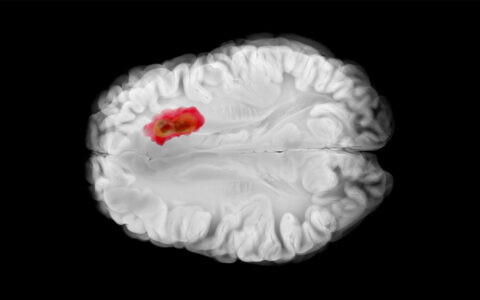When most people think of Parkinson’s disease, they picture the typical neurologic cascade of symptoms, including resting tremor, muscular rigidity, and bradykinesia.
However, a much rarer class of Parkinsonism syndromes present somewhat differently and with aggressive multisystem degeneration.
Sometimes called Parkinsonism-plus syndromes, these three related neurodegenerative diseases – progressive supranuclear palsy (PSP), corticobasal degeneration (CBD) and multiple system atrophy (MSA) – constitute atypical Parkinsonism. Dementia with Lewy bodies (DLB) is sometimes included with this group.
“These syndromes were originally described in the 1960s, but are rare, so you don’t hear about them,” said Amy E. Brown, M.D., assistant professor of neurology in the movement disorders division at Vanderbilt University Medical Center. “They are much more aggressive than Parkinson’s disease, with progression and functional decline occurring more rapidly. The survival rate is typically 6 to 10 years.”
“These disorders are much more aggressive than Parkinson’s disease, with progression and functional decline occurring more rapidly.”
CurePSP, based in New York City, is a nonprofit organization dedicated to increasing public awareness and advancing care and research for atypical Parkinsonism syndromes. The Vanderbilt Department of Neurology has been named a CurePSP Center of Care.
Brown led Vanderbilt’s application for the new designation.
“CurePSP’s Centers of Care network is stellar, and we are excited to officially join its ranks,” she said. “Besides boosting national recognition for our program, I foresee this new connection aiding local support for our patients.”
Complex Diagnoses
Parkinsonism-plus patients often initially display more common Parkinson’s symptoms, such as slowness in movement, rigidity and tremor. However, these patients have additional symptoms that vary, confusing the diagnosis.
There are significant differences in the disease mechanisms, Brown said.
In autopsy, progressive supranuclear palsy and corticobasal degeneration show up as tauopathies, while multiple system atrophy and dementia with Lewy bodies are synuclienopathies – as is Parkinson’s disease.
“One red flag is that standard Parkinson’s therapies frequently lack efficacy and often increase complications such as orthostatic hypotension,” she added.
PSP is the most common form of atypical Parkinsonism and affects 5 to 6 percent of all patients treated for the condition. Hallmarks include prominent early postural instability, early unexplained falls, and early dementia. Most PSP patients have some form of ocular dysfunction, usually vertical supranuclear gaze palsy.
MSA and DLB are more like Parkinson’s disease in pathology and more responsive to levodopa, though disease progression is different. MSA is associated with early urinary urgency and incontinence, blood pressure fluctuations and ataxia.
In CBD, an atypical Parkinsonism syndrome with predominant involvement of the cortex and basal ganglia, the classic presentation includes marked asymmetry and limb dystonia, with MRI showing asymmetric frontoparietal atrophy.
“In a DaTscan, these disorders look very similar to Parkinson’s disease, yet the areas of brain abnormality are not the same,” Brown said. “CT and MRI can help further delineate, but diagnosis is primarily based on clinical evaluation.”
“One red flag is that standard Parkinson’s therapies frequently lack efficacy and often increase complications.”
Fast-tracked Care
Vanderbilt University Medical Center has an established commitment to caring for patients with neurologic disorders. The Parkinson’s Disease Center is a Parkinson’s Foundation Center of Excellence and the Autonomic Dysfunction Clinic is one of the only specialized autonomic dysfunction programs in the U.S.
The multidisciplinary CurePSP Center draws on the resources of these two centers, bringing together a team of neurologists, nurse practitioners, physical therapists, neuropsychologists, speech-language pathologists, social workers, pharmacists and research coordinators dedicated to providing individualized clinical care for patients and their care partners.
“Patients with atypical Parkinsonism require complex care – and they need to be diagnosed early,” Brown said. “Team members are on site and available to see patients, often at the very same time and location as their Neurology Clinic appointment. This fast-tracking is critical, since these disorders progress so rapidly.”
Several support groups for Parkinson’s disease are offered at Vanderbilt, and there is an established network of PD support groups in Nashville and surrounding areas. Brown hopes to hold the CurePSP Center’s first support group meeting by the end of Summer 2024.
“We and other Parkinson’s centers have had great success with virtual meetings, so we’re starting with virtual meetings for the CurePSP group. It makes it so much easier for patients and care partners to participate – especially if they live outside of Nashville.”
On the research front, Brown is recruiting patients for two MSA drug trials, and Ryan Darby, M.D., assistant professor of neurology, is leading a prospective observational study involving PSP and CBD patients.
“The Department of Neurology has a robust research program, and our atypical Parkinsonism patients will benefit from its well-established infrastructure,” Brown said.
To reach out CurePSP center directly, providers can email CognitionAndMovement@vumc.org.




